2008 KIA Sportage check engine
[x] Cancel search: check enginePage 168 of 350
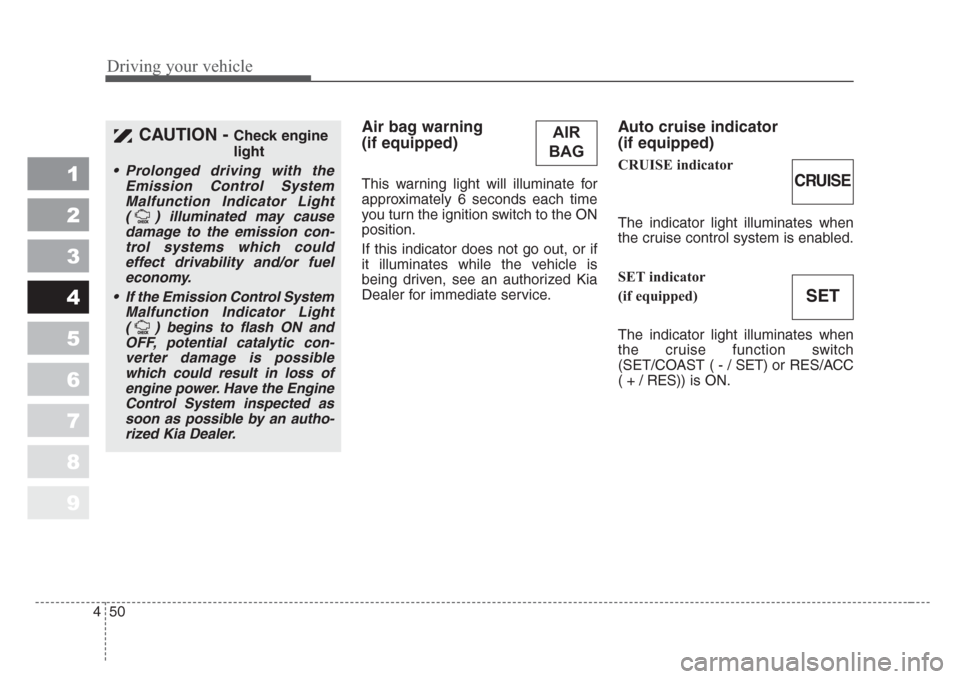
Driving your vehicle
50 4
1
2
3
4
5
6
7
8
9
Air bag warning
(if equipped)
This warning light will illuminate for
approximately 6 seconds each time
you turn the ignition switch to the ON
position.
If this indicator does not go out, or if
it illuminates while the vehicle is
being driven, see an authorized Kia
Dealer for immediate service.
Auto cruise indicator
(if equipped)
CRUISE indicator
The indicator light illuminates when
the cruise control system is enabled.
SET indicator
(if equipped)
The indicator light illuminates when
the cruise function switch
(SET/COAST ( - / SET) or RES/ACC
( + / RES)) is ON.
CAUTION - Check engine
light
• Prolonged driving with the
Emission Control System
Malfunction Indicator Light
() illuminated may cause
damage to the emission con-
trol systems which could
effect drivability and/or fuel
economy.
•
If the EmissionControl System
Malfunction Indicator Light
( ) begins to flash ON and
OFF, potential catalytic con-
verter damage is possible
which could result in loss of
engine power.Have the Engine
Control System inspected as
soon as possible by an autho-
rized Kia Dealer.
AIR
BAG
CRUISE
SET
Page 181 of 350
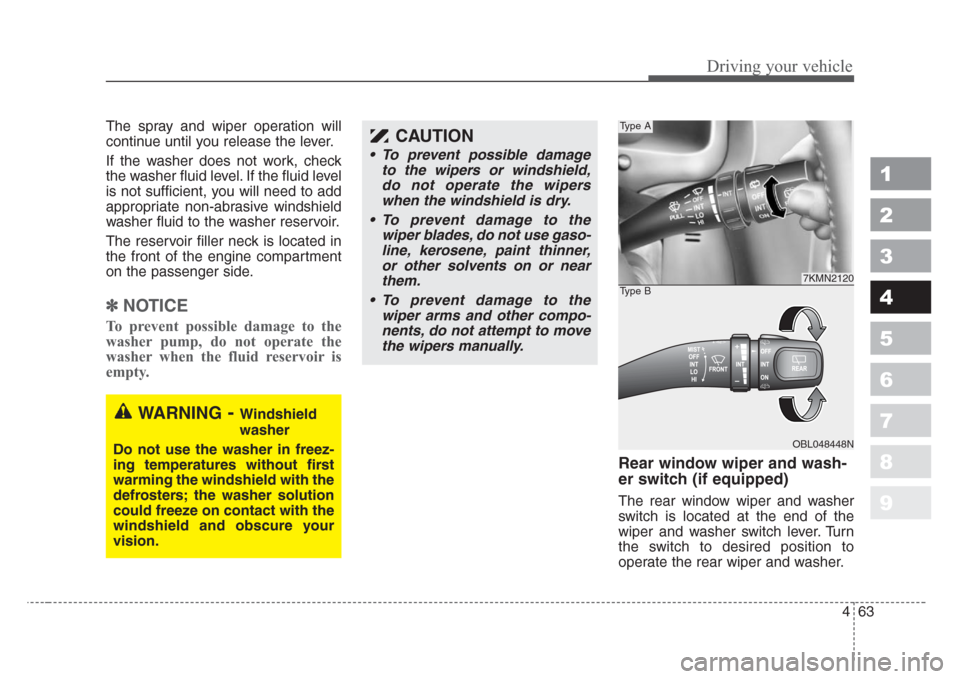
463
Driving your vehicle
1
2
3
4
5
6
7
8
9
The spray and wiper operation will
continue until you release the lever.
If the washer does not work, check
the washer fluid level. If the fluid level
is not sufficient, you will need to add
appropriate non-abrasive windshield
washer fluid to the washer reservoir.
The reservoir filler neck is located in
the front of the engine compartment
on the passenger side.
✽
NOTICE
To prevent possible damage to the
washer pump, do not operate the
washer when the fluid reservoir is
empty.
Rear window wiper and wash-
er switch (if equipped)
The rear window wiper and washer
switch is located at the end of the
wiper and washer switch lever. Turn
the switch to desired position to
operate the rear wiper and washer.
CAUTION
• To prevent possible damage
to the wipers or windshield,
do not operate the wipers
when the windshield is dry.
• To prevent damage to the
wiper blades, do not use gaso-
line, kerosene, paint thinner,
or other solvents on or near
them.
• To prevent damage to the
wiper arms and other compo-
nents, do not attempt to move
the wipers manually.
WARNING-Windshield
washer
Do not use the washer in freez-
ing temperatures without first
warming the windshield with the
defrosters; the washer solution
could freeze on contact with the
windshield and obscure your
vision.
7KMN2120
OBL048448N
Type A
Type B
Page 182 of 350
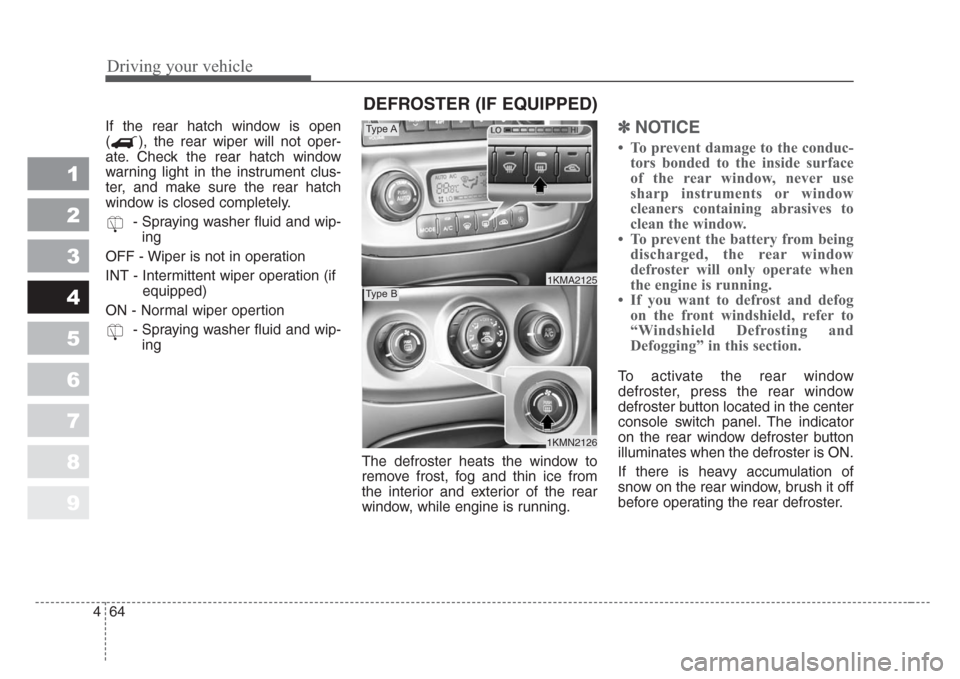
Driving your vehicle
64 4
1
2
3
4
5
6
7
8
9
If the rear hatch window is open
( ), the rear wiper will not oper-
ate. Check the rear hatch window
warning light in the instrument clus-
ter, and make sure the rear hatch
window is closed completely.
- Spraying washer fluid and wip-
ing
OFF - Wiper is not in operation
INT - Intermittent wiper operation (if
equipped)
ON - Normal wiper opertion
- Spraying washer fluid and wip-
ing
The defroster heats the window to
remove frost, fog and thin ice from
the interior and exterior of the rear
window, while engine is running.✽
NOTICE
• To prevent damage to the conduc-
tors bonded to the inside surface
of the rear window, never use
sharp instruments or window
cleaners containing abrasives to
clean the window.
• To prevent the battery from being
discharged, the rear window
defroster will only operate when
the engine is running.
• If you want to defrost and defog
on the front windshield, refer to
“Windshield Defrosting and
Defogging” in this section.
To activate the rear window
defroster, press the rear window
defroster button located in the center
console switch panel. The indicator
on the rear window defroster button
illuminates when the defroster is ON.
If there is heavy accumulation of
snow on the rear window, brush it off
before operating the rear defroster.
1KMN2126
1KMA2125
Type A
Type B
DEFROSTER (IF EQUIPPED)
Page 213 of 350
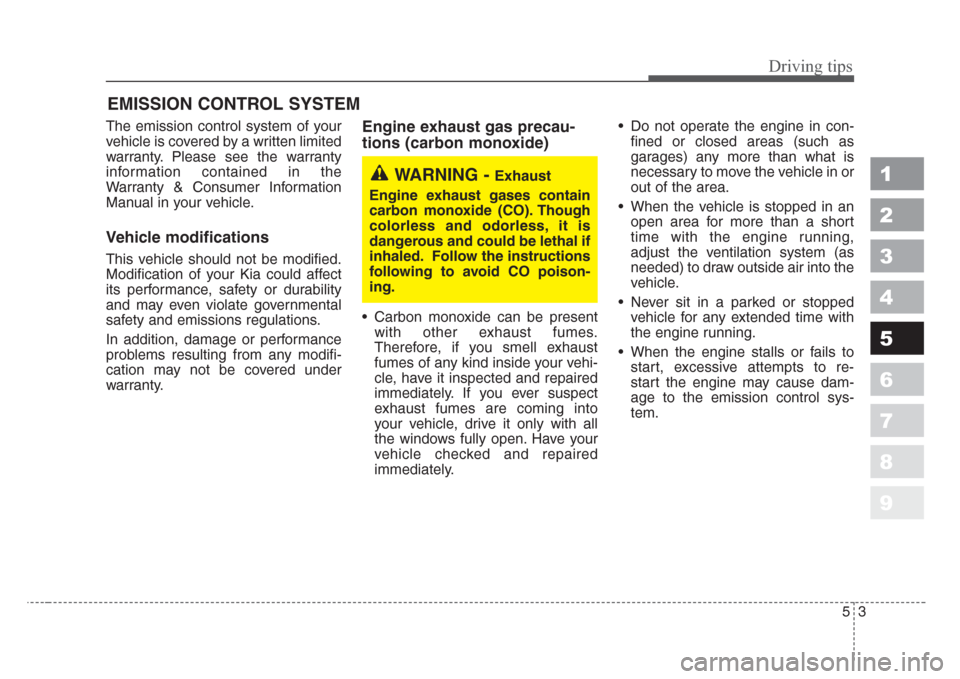
53
Driving tips
EMISSION CONTROL SYSTEM
The emission control system of your
vehicle is covered by a written limited
warranty. Please see the warranty
information contained in the
Warranty & Consumer Information
Manual in your vehicle.
Vehicle modifications
This vehicle should not be modified.
Modification of your Kia could affect
its performance, safety or durability
and may even violate governmental
safety and emissions regulations.
In addition, damage or performance
problems resulting from any modifi-
cation may not be covered under
warranty.
Engine exhaust gas precau-
tions (carbon monoxide)
• Carbon monoxide can be present
with other exhaust fumes.
Therefore, if you smell exhaust
fumes of any kind inside your vehi-
cle, have it inspected and repaired
immediately. If you ever suspect
exhaust fumes are coming into
your vehicle, drive it only with all
the windows fully open. Have your
vehicle checked and repaired
immediately.• Do not operate the engine in con-
fined or closed areas (such as
garages) any more than what is
necessary to move the vehicle in or
out of the area.
• When the vehicle is stopped in an
open area for more than a short
time with the engine running,
adjust the ventilation system (as
needed) to draw outside air into the
vehicle.
• Never sit in a parked or stopped
vehicle for any extended time with
the engine running.
• When the engine stalls or fails to
start, excessive attempts to re-
start the engine may cause dam-
age to the emission control sys-
tem.
1
2
3
4
5
6
7
8
9WARNING - Exhaust
Engine exhaust gases contain
carbon monoxide (CO).Though
colorless and odorless,it is
dangerous and could be lethal if
inhaled.Follow the instructions
following to avoid CO poison-
ing.
Page 215 of 350
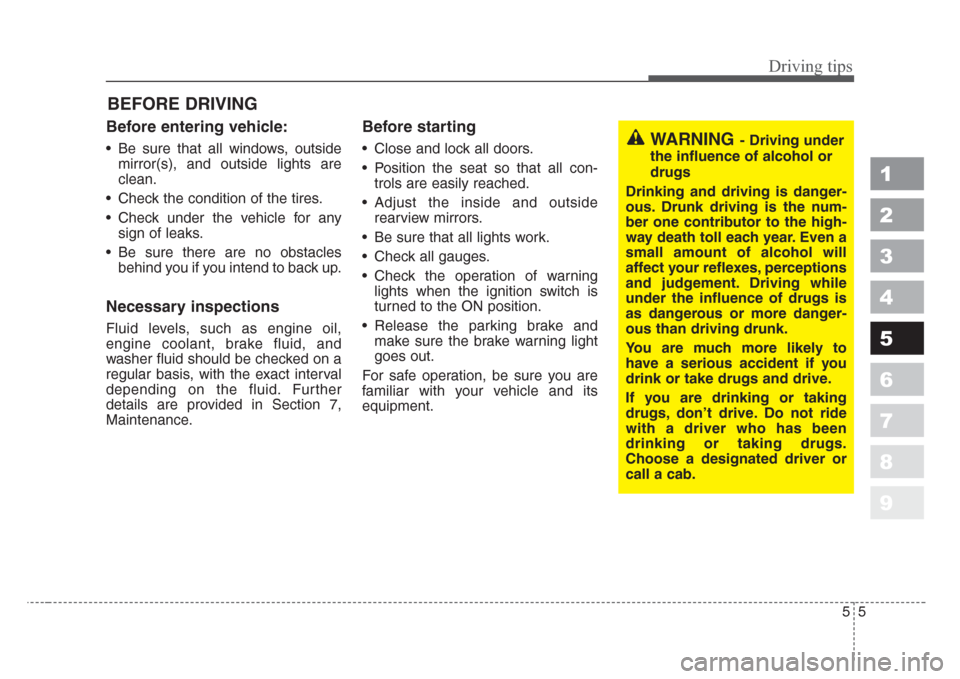
55
Driving tips
BEFORE DRIVING
Before entering vehicle:
• Be sure that all windows, outside
mirror(s), and outside lights are
clean.
• Check the condition of the tires.
• Check under the vehicle for any
sign of leaks.
• Be sure there are no obstacles
behind you if you intend to back up.
Necessary inspections
Fluid levels, such as engine oil,
engine coolant, brake fluid, and
washer fluid should be checked on a
regular basis, with the exact interval
depending on the fluid. Further
details are provided in Section 7,
Maintenance.
Before starting
• Close and lock all doors.
• Position the seat so that all con-
trols are easily reached.
• Adjust the inside and outside
rearview mirrors.
• Be sure that all lights work.
• Check all gauges.
• Check the operation of warning
lights when the ignition switch is
turned to the ON position.
• Release the parking brake and
make sure the brake warning light
goes out.
For safe operation, be sure you are
familiar with your vehicle and its
equipment.
1
2
3
4
5
6
7
8
9
WARNING- Driving under
the influence of alcohol or
drugs
Drinking and driving is danger-
ous.Drunk driving is the num-
ber one contributor to the high-
way death toll each year.Even a
small amount of alcohol will
affect your reflexes, perceptions
and judgement.Driving while
under the influence of drugs is
as dangerous or more danger-
ous than driving drunk.
You are much more likely to
have a serious accident if you
drink or take drugs and drive.
If you are dr
inking or taking
drugs, don’t drive.Do not ride
with a driver who has been
drinking or taking drugs.
Choose a designated driver or
call a cab.
Page 220 of 350
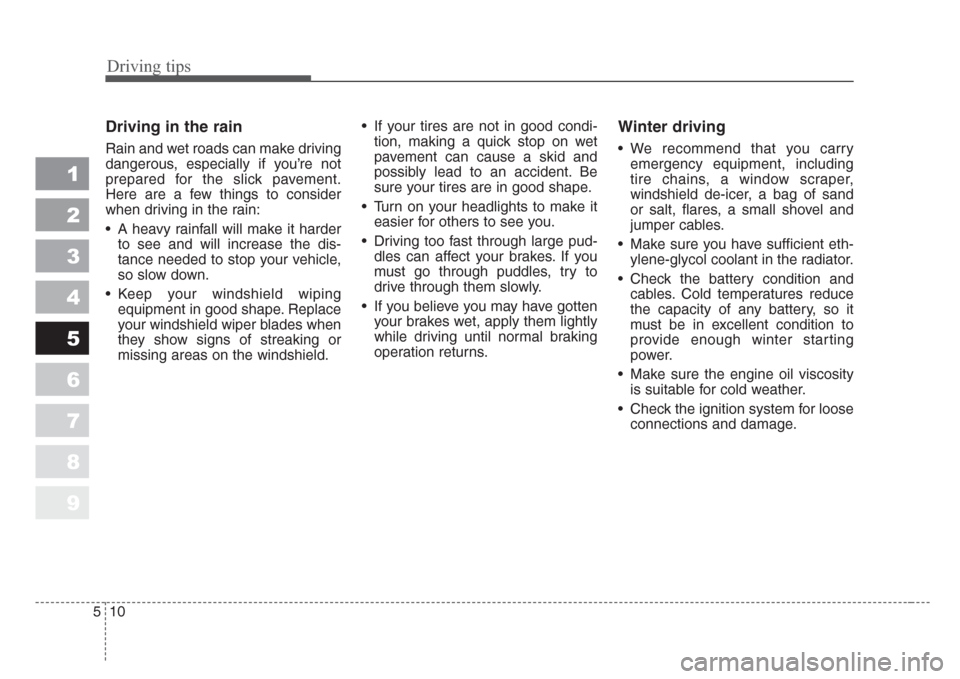
Driving tips
10 5
1
2
3
4
5
6
7
8
9
Driving in the rain
Rain and wet roads can make driving
dangerous, especially if you’re not
prepared for the slick pavement.
Here are a few things to consider
when driving in the rain:
• A heavy rainfall will make it harder
to see and will increase the dis-
tance needed to stop your vehicle,
so slow down.
• Keep your windshield wiping
equipment in good shape. Replace
your windshield wiper blades when
they show signs of streaking or
missing areas on the windshield.• If your tires are not in good condi-
tion, making a quick stop on wet
pavement can cause a skid and
possibly lead to an accident. Be
sure your tires are in good shape.
• Turn on your headlights to make it
easier for others to see you.
• Driving too fast through large pud-
dles can affect your brakes. If you
must go through puddles, try to
drive through them slowly.
• If you believe you may have gotten
your brakes wet, apply them lightly
while driving until normal braking
operation returns.
Winter driving
• We recommend that you carry
emergency equipment, including
tire chains, a window scraper,
windshield de-icer, a bag of sand
or salt, flares, a small shovel and
jumper cables.
• Make sure you have sufficient eth-
ylene-glycol coolant in the radiator.
• Check the battery condition and
cables. Cold temperatures reduce
the capacity of any battery, so it
must be in excellent condition to
provide enough winter starting
power.
• Make sure the engine oil viscosity
is suitable for cold weather.
• Check the ignition system for loose
connections and damage.
Page 221 of 350
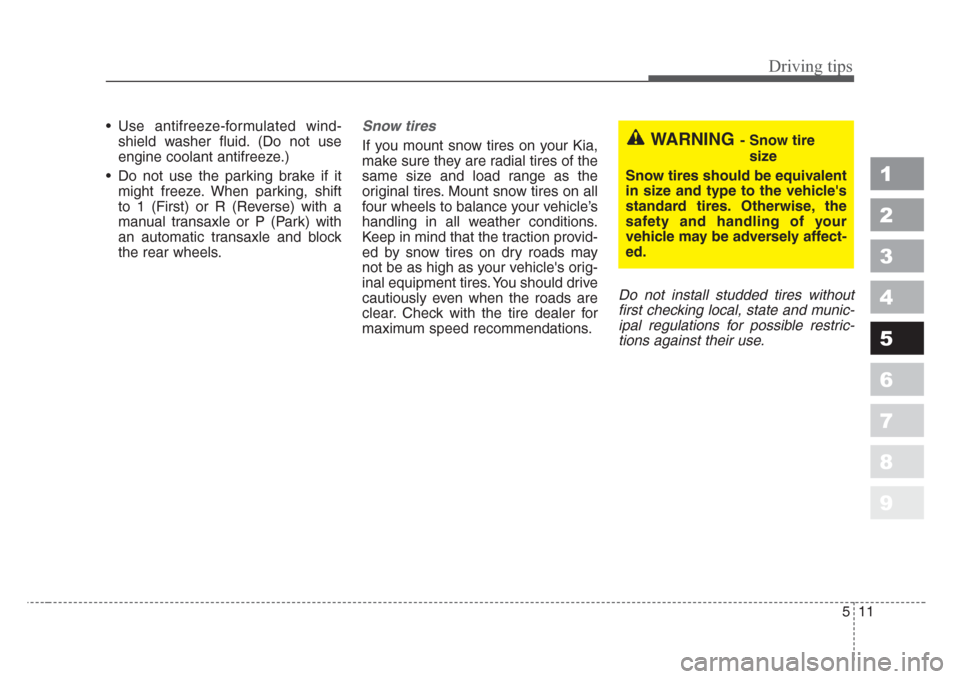
511
Driving tips
1
2
3
4
5
6
7
8
9
• Use antifreeze-formulated wind-
shield washer fluid. (Do not use
engine coolant antifreeze.)
• Do not use the parking brake if it
might freeze. When parking, shift
to 1 (First) or R (Reverse) with a
manual transaxle or P (Park) with
an automatic transaxle and block
the rear wheels.Snow tires
If you mount snow tires on your Kia,
make sure they are radial tires of the
same size and load range as the
original tires. Mount snow tires on all
four wheels to balance your vehicle’s
handling in all weather conditions.
Keep in mind that the traction provid-
ed by snow tires on dry roads may
not be as high as your vehicle's orig-
inal equipment tires. You should drive
cautiously even when the roads are
clear. Check with the tire dealer for
maximum speed recommendations.
Do not install studded tires without
first checking local, state and munic-
ipal regulations for possible restric-
tions against their use.
WARNING- Snow tire
size
Snow tires should be equivalent
in size and type to the vehicle's
standard tires.Otherwise, the
safety and handling of your
vehicle may be adversely affect-
ed.
Page 224 of 350
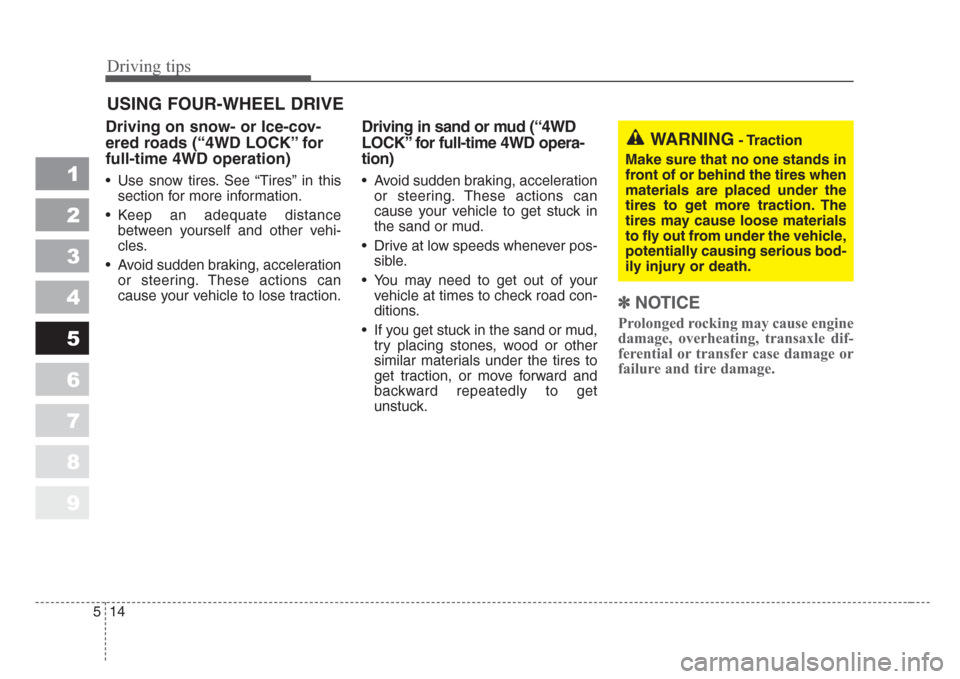
Driving tips
14 5
1
2
3
4
5
6
7
8
9
USING FOUR-WHEEL DRIVE
Driving on snow- or Ice-cov-
ered roads (“4WD LOCK”for
full-time 4WD operation)
• Use snow tires. See “Tires” in this
section for more information.
• Keep an adequate distance
between yourself and other vehi-
cles.
• Avoid sudden braking, acceleration
or steering. These actions can
cause your vehicle to lose traction.
Driving in sand or mud (“4WD
LOCK”for full-time 4WD opera-
tion)
• Avoid sudden braking, acceleration
or steering. These actions can
cause your vehicle to get stuck in
the sand or mud.
• Drive at low speeds whenever pos-
sible.
• You may need to get out of your
vehicle at times to check road con-
ditions.
• If you get stuck in the sand or mud,
try placing stones, wood or other
similar materials under the tires to
get traction, or move forward and
backward repeatedly to get
unstuck.
✽
NOTICE
Prolonged rocking may cause engine
damage, overheating, transaxle dif-
ferential or transfer case damage or
failure and tire damage.
WARNING- Traction
Make sure that no one stands in
front of or behind the tires when
materials are placed under the
tires to get more traction.The
tires may cause loose materials
to fly out from under the vehicle,
potentially causing serious bod-
ily injury or death.